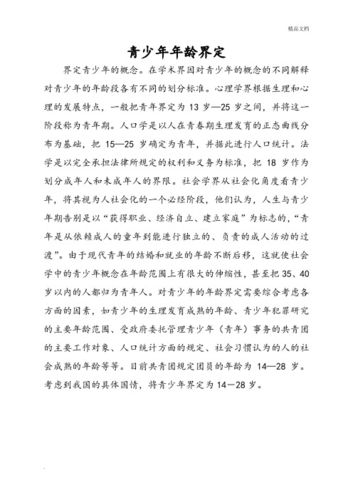您所在的位置:首页 - 文化 - 正文文化
文学的界限
![]() 再意
2024-05-14
【文化】
768人已围观
再意
2024-05-14
【文化】
768人已围观
摘要**ExploringtheBoundariesofLiterature**Inthevastrealmofhumanexpression,literaturestandsasacornerstone
Exploring the Boundaries of Literature
In the vast realm of human expression, literature stands as a cornerstone of culture, reflecting and shaping the world in which we live. But what exactly are the boundaries of literature? This question delves into the essence of what constitutes literature, its forms, its purpose, and its relationship with other modes of expression. Let's embark on a journey to explore these boundaries and gain a deeper understanding of the rich tapestry of literary art.
Defining Literature
At its core, literature encompasses written works that possess artistic merit and convey meaning through language. Traditional forms include novels, poetry, plays, and essays. These forms often adhere to established structures and conventions, but literature is not confined solely to these formats. In the modern era, literature has expanded to include digital mediums, such as blogs, social media posts, and interactive fiction.
The Boundaries of Genre
Genres serve as categories that help readers navigate the diverse landscape of literature. From romance to science fiction, each genre offers a distinct set of conventions and themes. However, the boundaries between genres are not rigid; they often blur, giving rise to hybrid forms like historical fantasy or literary thriller. This fluidity allows writers to experiment and push the boundaries of traditional storytelling.
Literature and Other Art Forms
Literature shares connections with various artistic disciplines, including film, visual art, and music. Adaptations of literary works into other mediums demonstrate the interplay between different forms of expression. Similarly, literature often draws inspiration from visual imagery, musical motifs, and cinematic techniques. These crossdisciplinary influences enrich the literary landscape, fostering creativity and innovation.
Cultural and Linguistic Diversity
The boundaries of literature extend beyond language and cultural barriers, encompassing a global array of voices and perspectives. Translated works offer readers access to literature from different cultures, while multicultural societies produce literature that reflects diverse experiences and identities. Embracing this diversity enriches our understanding of humanity and fosters empathy across borders.
Pushing the Boundaries
Literature has a long history of challenging societal norms and pushing the boundaries of artistic expression. Works that explore taboo subjects or employ unconventional narrative techniques often provoke critical debate and reflection. Writers like James Joyce, Virginia Woolf, and Gabriel García Márquez have pushed the boundaries of literary form, inspiring future generations to experiment and innovate.
Digital Literature and New Frontiers
The advent of digital technology has revolutionized the way we create, consume, and interact with literature. Digital literature encompasses a wide range of experimental forms, including hypertext fiction, interactive storytelling, and electronic poetry. These innovative works redefine the boundaries of narrative structure and reader participation, inviting audiences to engage with literature in new and immersive ways.

Conclusion: Embracing the Infinite Possibilities
In conclusion, the boundaries of literature are as vast and everchanging as the human imagination. From traditional forms to digital experiments, literature continues to evolve, adapt, and challenge our perceptions of what it means to tell a story. By embracing diversity, innovation, and exploration, we can unlock the infinite possibilities of literary expression and enrich our lives in the process.
Now, as we navigate the boundless realm of literature, let us celebrate its power to inspire, provoke, and unite us in our shared human experience.
Tags: 文学的界定 简述文学的界说 文学的界限 文学界限是什么意思啊
版权声明: 感谢您对【奚诗百科网】网站平台的认可,无特别说明,本站所有文章均归【奚诗百科网】平台所有,转载请说明文章出处“来源【奚诗百科网】”。 https://www.sptgyg.com/post/5564.html
上一篇: 秦川纹绣是什么人物
下一篇: 中国文学作品人物介绍
最近发表
- 考研路上的钱包指南,预算大揭秘
- 华为MatePad Pro,您的智能生活新伙伴
- 时光回响,一千首经典老歌曲大全
- 考研路上的灯塔,揭秘考研辅导机构的神奇力量
- 穿越时空的旋律,一千首经典老歌曲的不朽魅力
- 旋律中的世界,全球著名音乐剧的魅力与影响
- 三星手机图片大全,视觉盛宴,科技与美学的结晶
- 旋律中的世界,探索全球著名音乐剧的魅力
- 三星W系列手机,高端奢华与卓越性能的完美结合
- 函授硕士研究生报考条件,开启你的远程学习之旅
- 英文经典音乐剧,穿越时空的旋律与故事
- 福建省美术学院排名大揭秘,艺术殿堂的十座灯塔
- 探索京城,北京免费景点全攻略
- 四书五经,古典智慧的宝库
- 索尼摄像机使用指南,轻松掌握拍摄技巧
- 考研路上的灯塔,为何选择多样的考研课程至关重要
- 旋律与梦想,探索著名英语音乐剧的魅力与影响
- 电影中的音乐之旅,西方音乐电影的魅力与启示
- 深入了解考研课程班的费用,一个全面的指南
- 探索北京,揭秘免门票的宝藏景区
- 考研课程费用解析,如何判断合适的投资
- 艺术之门,揭秘美术公办二本最低分数线的秘密
- 探索北京,十大必去景点深度游
- 舞动经典,探索歌舞剧电影的魅力
- 戴尔最新款笔记本型号,性能、特点与购买指南
- 深入解析,考研课程费用大揭秘
- 揭秘考研课程费用,如何辨别正规课程,避免经济与时间的双重损失
- 荣耀Magic系统,智能生活的新篇章
- 电影之旅,探索英美经典电影的魅力
- 考研路上的金钥匙,揭秘考研课程的价值与成本
- 探索北京,十大免费景点排名及深度体验指南
- 探索云端世界,华为云账号登录官网的便捷之旅
- 舞动梦想,歌唱生活,美国歌舞剧电影的魅力与影响
- 2023年十大名牌手机,科技与设计的巅峰对决
- 苹果与富士康的舞步,全球供应链中的合作与挑战
- 三星GTS3850,智能生活,触手可及
- 艺术之门,2023年美术学院录取分数线排名解析
- 探索北京,免费景点的宝藏之旅
- 探索金沙三宝,揭开神秘面纱,发现生活的艺术
- 三星2016年的辉煌时刻,价格与价值的双重奏
- 音乐剧的璀璨明珠,三宝作品全解析
- 考研课程价格表,透明化选择,助力你的考研之路
- 探索文学的宝库,文学类书籍类型大全
- 三宝,中国音乐剧的瑰宝与创作之旅
- 三宝音乐会,音乐与灵魂的交响曲
- 2023年985大学排名名单,教育质量与学术实力的较量
- 文学类书籍的多彩世界,探索书籍分类的艺术之旅
- 探索文学的多彩世界,文学类书籍类型的全面解析
- 三宝音乐剧蝶完整版,一场视听盛宴的深度解析
- 孩子学四书五经有用吗?探索古典智慧的现代价值


